Congratulations to our seniors, Zack and Anya, who graduated this weekend. Anya graduated from Biomedical Engineering, and Zack graduated from the Materials Science and Engineering Department.
We’re so proud of you guys!
Translational Orthopaedic Research Laboratory
Part of the Joint Department of Biomedical Engineering at NC State University and UNC-Chapel Hill
It was a beautiful North Carolina spring day. The sun was shining, it was a perfect 80 degrees, and there wasn’t a cloud in the sky. No one spoke, or even dared to breathe. It came down to this one stroke. If AJ could get a hole in one on the 18th hole (regarded by many experts to be the most difficult hole of the course), he would beat Matt and end his 2-year winning streak. He set up the ball. He planted his feet. He rocked back on his heels a bit. A bird chirped in the distance. AJ pulled back the putter and gently tapped the ball. It was good! The ball was going straight for the hole! But alas, the surface was not flat, as is the wont of mini golf courses the world over, and the ball quickly veered off course, rolling down the hill and, with it, the chance of unseating Matt. Everyone (other than Matt) groaned and swore to practice harder for next year.
Despite the very upsetting end to the day, we all had a great time at our annual mini golf competition. Matt won (again…) and AJ, as second place winner, got to pick the SnoBall flavors for Stephane C, the loser. Unfortunately for AJ, Stephanie didn’t find the orchid/spearmint flavor combination quite as gross as he had hoped.
Sleep with one eye open Matt. We’ll get you eventually!
Stats for Annual Mini Golf Competition:
| Winner
(Can bequeath privilege of picking SnoBall flavor) |
2nd Place
|
Loser
(Eats SnoBall) |
|
| 2016 | Matt | Steph T | Paul |
| 2017 | Matt | Paul | Jay |
| 2018 | Matt | AJ | Stephanie C |
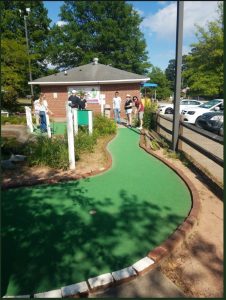 The setting The setting |
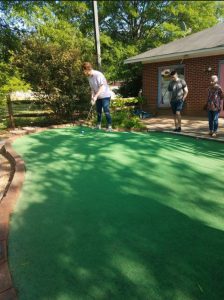 Emily lines up a shot Emily lines up a shot |
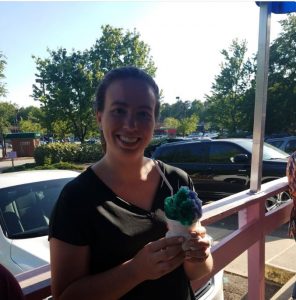 Stephanie wasn’t nearly as grossed out by her loser’s Sno Cone as AJ had hoped
Stephanie wasn’t nearly as grossed out by her loser’s Sno Cone as AJ had hoped
Our recent R01 grant application was funded by the NIH! The proposal, titled “Sex- and Age-Dependent ACL Function in the Growing Knee Joint” has been funded for $1.6 million dollars from April 2018 through March of 2023. You can see more about the award here, or scroll down to see and abstract and the public health relevance of our research.
Per the NIH, “The Research Project Grant (R01) is the original and historically oldest grant mechanism used by NIH. The R01 provides support for health-related research and development based on the mission of the NIH”.
| Abstract Text: |
|---|
| Recent data indicates that the fastest rising rates of anterior cruciate ligament (ACL) injuries of the knee are reported in children and adolescents with significant growth remaining. In the skeletally immature patient population, surgical reconstruction is increasingly suggested for complete ACL tears. However, the choice of non-surgical treatment or immediate surgical reconstruction of ACL tears remains a subject of debate in young patients with significant growth remaining or in the case of partial tears involving one ACL bundle. Sex appears to be a major risk factor for ACL injury during adolescence, but not in childhood, adding another layer of complexity. For both complete and partial ACL injuries, treatment algorithms have been developed without considering the potential sex- and age-dependent function of the ACL, due to the paucity of available data. Thus, the objective of this proposal is to determine how age and sex impact ACL maturation and joint function during skeletal growth and to assess if this knowledge can be applied to improve treatment after ACL injury. Aim 1 will determine how sex impacts the maturation of the ACL as well as that of its individual AM and PL bundles during skeletal growth. Aim 2 will determine how age and sex impact the immediate loading of secondary tissues in-vitro and the remodeling response of the joint in-vivo following loss of function of the AM bundle, PL bundle, or the entire ACL. Aim 3 will determine how replacement graft type and placement should vary to restore age- and sex-specific ACL and joint function. Successful completion of these aims will provide a basic science foundation for the development of age- and sex-specific algorithms for the treatment of ACL injuries. |
|
Public Health Relevance Statement: |
| With increasing activity and participation in organized sports within children and adolescents, injuries to the anterior cruciate ligament (ACL) of the knee joint are rising dramatically, and appropriate age- and sex- dependent treatment algorithms are still unclear. The goal of this proposal is to determine how age and sex impact ACL maturation and joint function during skeletal growth and to assess if this knowledge can be applied to improve treatment after ACL injury. Such information will be critical to guide sex- and age-specific treatment strategies for children or adolescents with ACL injuries and significant remaining growth, and the knowledge obtained can be extended to guide new surgical and/or non-operative treatment. |
It’s that time of year again! Spring means outreach (we love outreach year round, but opportunities seem to crop up in the spring).
Congratulations to Stephanie Cone, who was selected by the UNC graduate school as a 2018 Horizon Award recipient for her thesis work. Check it out!

The Graduate Education Advancement Board Horizon Award recognizes graduate students whose research holds extremely high potential for making a significant contribution to the educational, economic, physical, social or cultural well-being of North Carolina citizens and beyond at some future time. More info about the award can be found here.
Apologies for the long silence, but we’ve been busy with our exciting news: we’ve moved! Our lab is now located in the brand new Biomedical Partnership Center at the Center for Veterinary Medicine at NC State.
We’re sad to leave behind EB3, but excited about the possibilities for closer collaboration with our colleagues at the vet school. Plus we’re excited to have a lot more space, and it’s still shiny and new!
Photos of our new space will come once we have it all set up, but in the mean time we’d like to say a fond farewell to our old lab.
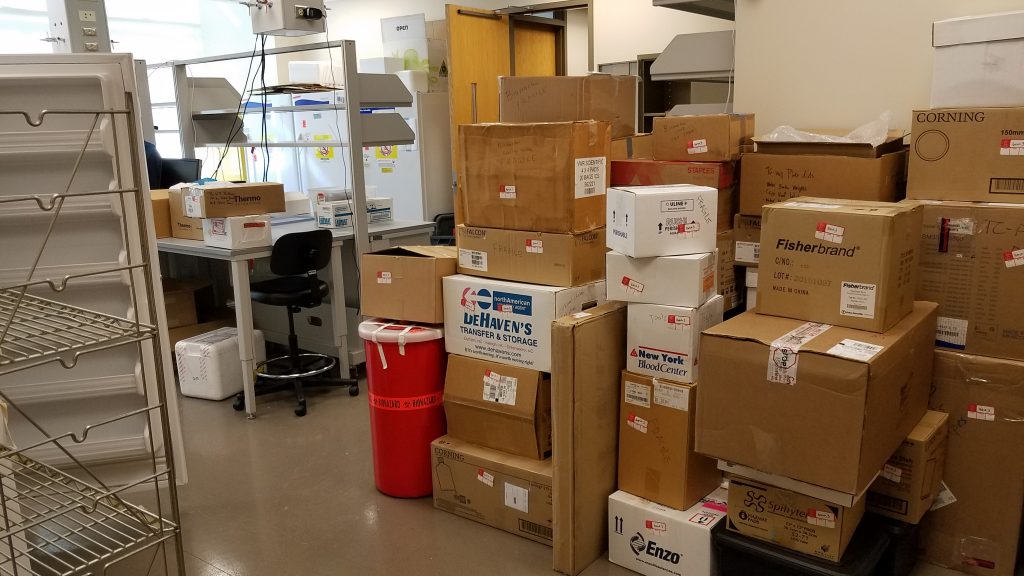
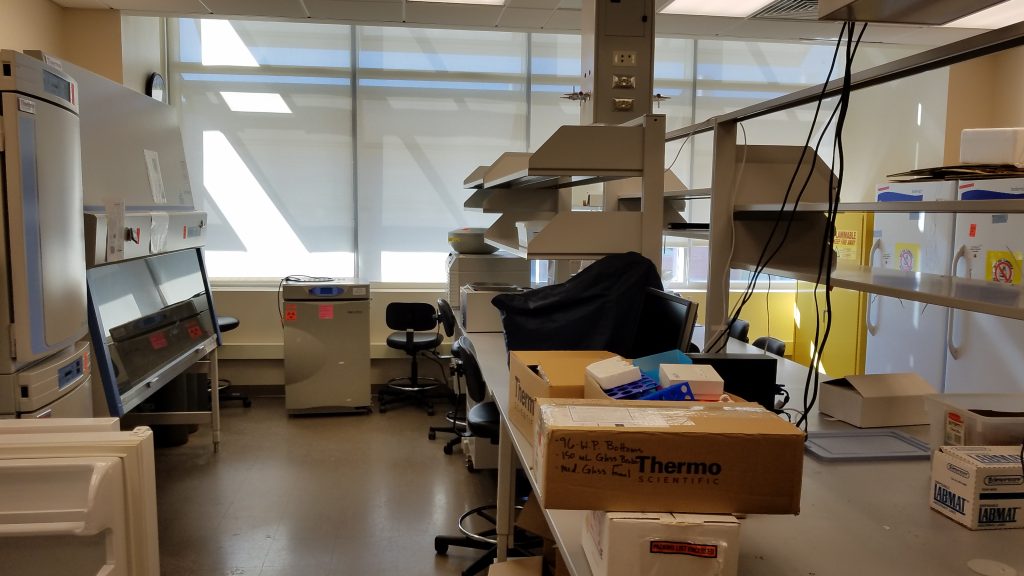
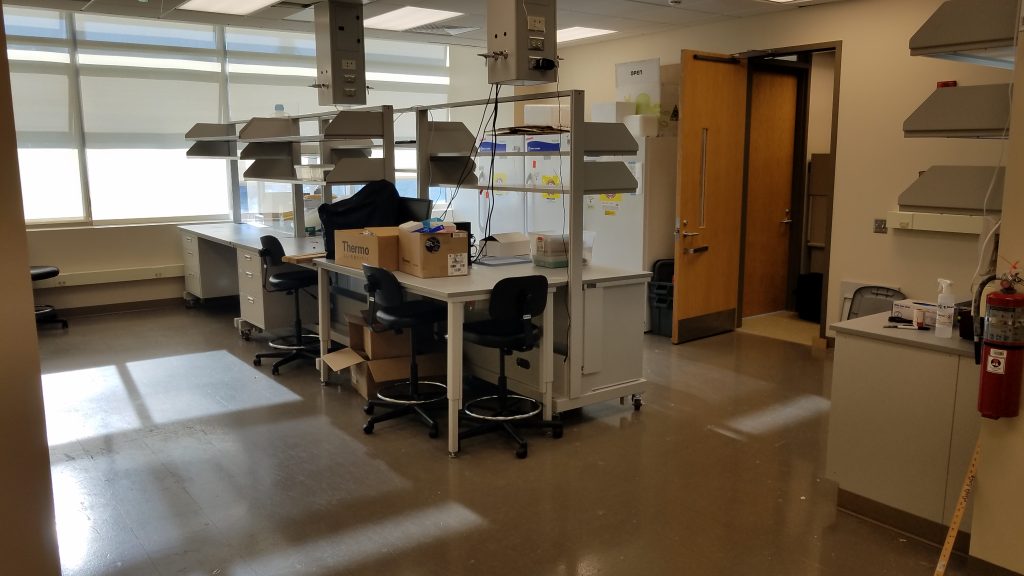
TORL got together over the weekend to celebrate the holidays. As is to be expected at any -sgiving event, much fun (and way too much food) was had by all. Check out a few photos below.
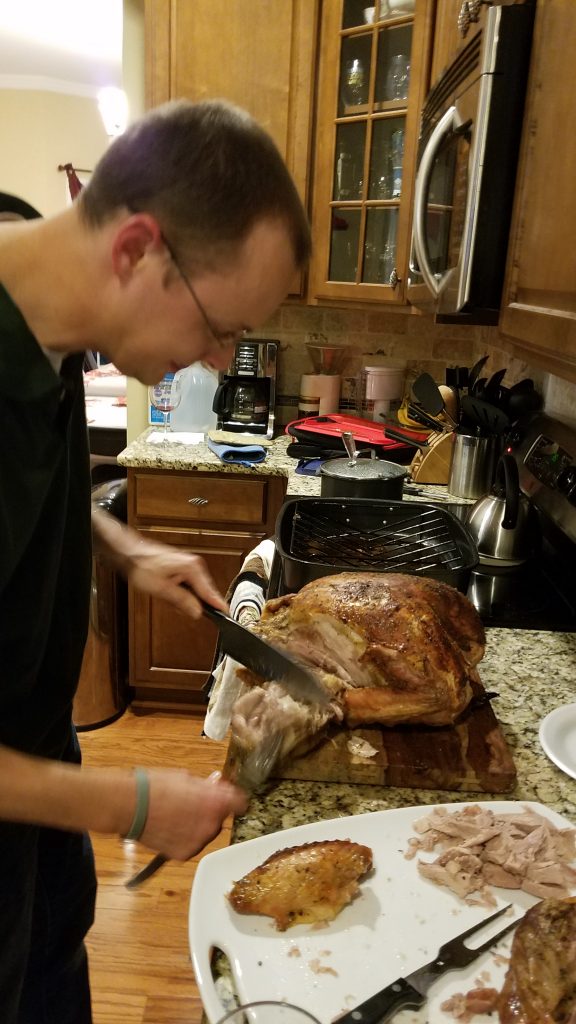
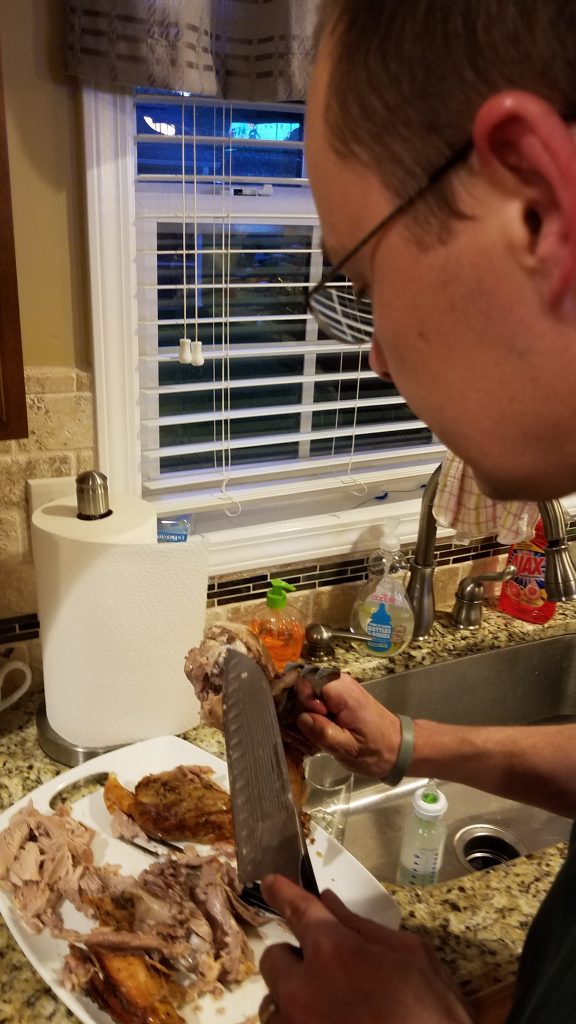
Happy Holidays everyone!

Latest Research on Animal Models in Regenerative Medicine Featured in Upcoming Special Issue of Tissue Engineering
New Rochelle, NY, October 24, 2017—Novel approaches to tissue engineering and regenerative medicine are first evaluated and optimized in animal models before making the leap to clinical testing in human subjects. For many of these innovative new techniques and materials to succeed and advance to the clinic, the selection of an appropriate animal model and design of the experiments to gauge performance and outcomes can determine whether a particular approach, and the field in general, continue to move forward. A special issue devoted to the latest research on using animal models in regenerative medicine research is forthcoming in Tissue Engineering, Part C, a peer-reviewed journal from Mary Ann Liebert, Inc., publishers. Select articles from the issue are now available online on the Tissue Engineering website.
Guest Editors Jorge Piedrahita, PhD, North Carolina State University College of Veterinary Medicine, Raleigh, and J. Koudy Williams, DVM, Wake Forest School of Medicine, Winston Salem, NC oversaw the development of the special issue. They compiled a series of outstanding papers on diverse topics contributed by leading researchers. These include the article entitled “Inflammation-Induced Osteogenesis in a Rabbit Tibia Model,” in which F. Cumhur Öner, MD, PhD, et al., University Medical Center Utrecht, Delft University of Technology, and Utrecht University, The Netherlands, examined the inflammatory responses to bacterial infection that can promote bone formation. The researchers showed that the inflammatory response caused by exposure to Staphylococcus aureus antigens, in the absence of bacterial infection, could stimulate bone growth and might be a useful strategy in bone regenerative medicine.
In the article “Rise of the Pigs: Utilization of the Porcine Model to Study Musculoskeletal Biomechanics and Tissue Engineering During Skeletal Growth,” Matthew Fisher, PhD and coauthors from North Carolina State University, University of North Carolina at Chapel Hill and UNC School of Medicine, present the unique opportunities and challenges for using pigs as translational models in the development of musculoskeletal regenerative medicine approaches. In particular, the researchers describe the advantages porcine models offer for studying biomechanics.
Johan Lammens, MD, PhD and coauthors from University Hospitals KU Leuven, KU Leuven, Medanex Clinic (Diest), and University of Liège, Belgium, caution that techniques for repairing large bone defects developed in the laboratory will only ultimately be successful in humans if the preclinical studies are performed in a reliable animal model using a bone defect of sufficient size created by following well-defined methods. They share their perspectives in the article entitled “Warning About the Use of Critical-Size Defects for the Translational Study of Bone Repair: Analysis of a Sheep Tibial Model.”
“This special issue emphasizes not only the need for appropriate animal models to increase our understanding and knowledge, but also for the final clinical application of regenerative medicine-based products,” says Methods Co-Editor-in-Chief John A. Jansen, DDS, PhD, Professor and Head, Department of Biomaterials, Radboud University Medical Center, The Netherlands.
For the first time, out lab participated in SciREN, which aims to connect local STEM researchers and educators to foster the dissemination of current research and ultimately enhance the science literacy of today’s youth. Stephanie wrote a great lesson plan for the Invite a Scientist program, we decided we’d share it with even more educators.
Our booth was quite popular, thanks to the 3D printer that we had running all night, and the candy we gave out didn’t hurt either. We got some great feedback from the people there, and hopefully some of them will use our lesson plan in their classrooms!
Here are some photos of us in action!
———————————————————
We feel so official!
Talking to educators!
AJ was granted an Abrams Scholar Award to work on the project “Direct wire melt electrospinning for musculoskeletal soft tissue engineering”. He will be working with Zack and Paul on the project.
About the Abrams Scholars Program:
Abrams Scholars are outstanding BME undergraduate students who are selected to receive a stipend to conduct hands-on laboratory research projects. These projects are conceived and designed by the students with the guidance of a faculty mentor. The Abrams Scholar program honors C. Frank Abrams, Jr., a BME and BAE emeritus faculty member. Dr. Abrams led the development of the first courses in Biomedical Engineering at NC State and was instrumental in the founding of NC State’s BME Department, the creation of the joint UNC-CH/NC State graduate program, and ultimatel,y the launch of the UNC-CH/NC State Joint BME Department. He was the Joint Department’s first senior design instructor as well as the first Director of Graduate Studies.
We’ve been busy over the summer here in the TORL. We’ve recently had two papers published. One from our grad student, Stephanie C and Paul, and one that was a collaboration with members of Robert Mauck’s lab at UPenn (where Matt did his post-doc).
Check out the one from Stephanie and Paul (and Matt), called “Rise of the Pigs” here. It’s a review of the use of a porcine model for tissue engineering and regenerative medicine (TERM) research.
The other paper, found here, focuses on subchondral bone remodeling following various types of injury and repair approaches.
Congratulation to Jay, who recently presented his research at the Summer Undergraduate Research Symposium!
Jay presenting his SIRI summer research project. #SummerURS@NCStateCMI@BioInterfaceLabpic.twitter.com/Phw63hUy4y
— Matt Fisher (@mattbfish) August 1, 2017